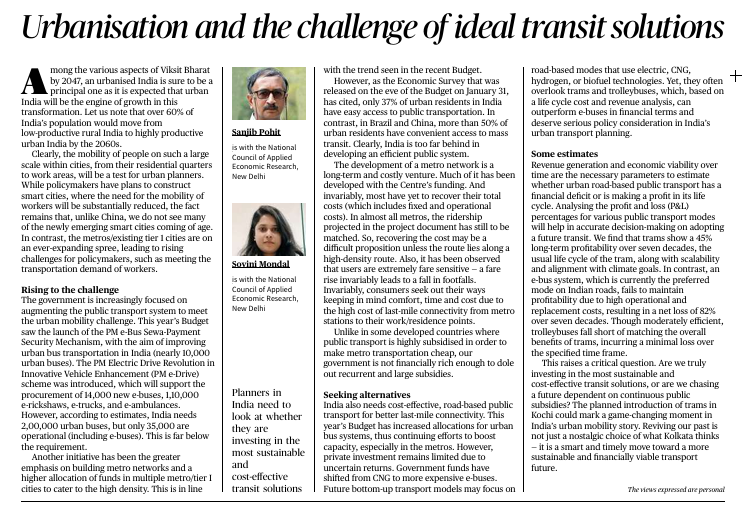Context and Background
- As part of India’s urbanisation drive under Viksit Bharat@2047, urban mobility is crucial to making cities productive, sustainable, and livable.
- With over 60% of India’s population projected to live in urban areas by 2047, resolving urban transport challenges is central to supporting economic growth and inclusive development.
- The editorial evaluates the limitations of current transit systems, policy gaps, and the need for a sustainable, cost-effective, and inclusive public transportation strategy.
Key Issues Raised
1. Rising Mobility Challenges in Urban India
- Workers in India often live far from their workplaces, especially in large cities.
- Unlike Chinese cities which were built around modern mobility needs, Indian urban infrastructure is retrofitted, causing a constant mismatch between infrastructure and rising demand.
- The burden falls on policymakers to solve for this increasing demand in the absence of foundational urban planning.
2. Government’s Focus on E-Mobility
- Through schemes like PM-eBus Sewa and the National Electric Vehicle Policy, India is attempting to modernize urban mobility via electric transport modes.
- The plan to deploy 10,000 e-buses in 100 cities is aimed at making public transport greener and more accessible.
Limitation: Electrification is necessary, but electric buses alone are not sufficient unless embedded in a broader multi-modal, efficient, and user-friendly public transit system.
3. Gap in Public Transit Accessibility
- Only 37% of urban residents had access to public transport in 2017.
- Over 50% still lack access to mass transit, due to poor connectivity, low investments, and sub-optimal policy integration.
- There is a gap between availability and accessibility, as projects tend to be capital-intensive, cost-ineffective, and poorly planned.
4. Financial Viability and Policy Disconnect
- Metro rail systems, although environmentally friendly, are costly to build and operate, often failing to recover capital and operational expenditures.
- User fare sensitivity and lack of viable alternatives mean these systems often operate at a loss or with very low profitability, despite heavy public subsidies.
Policy Flaw: Investment decisions are not always backed by proper ridership and revenue projections, leading to misalignment between cost, usage, and viability.
5. Need for Holistic, Context-Specific Planning
- Future transit must be tailored to each city’s:
- Size and density
- Land use patterns
- Economic activities
- User income profile
- Size and density
- Life-cycle costing and sustainability should guide investment choices.
- Often overlooked modes like electric rickshaws, CNG buses, bicycles, and BRT (Bus Rapid Transit) offer more cost-effective and scalable alternatives.
6. Way Forward: Toward Ideal Urban Transit
- A continuous public mobility audit is required to measure and correct inefficiencies.
- A strong case is made for data-driven planning, considering:
- Return on investment (ROI)
- Per kilometre cost and ridership
- Environmental and social benefits
- Return on investment (ROI)
- Low-cost, high-frequency transit models (e.g., shared autos, e-buses, e-rickshaws) can be more impactful in tier 2 and 3 cities.
Conclusion
The editorial underlines the urgent need to rethink India’s urban transport strategy. Moving beyond headline-grabbing metro projects, India needs a diverse, context-specific, and affordable transit ecosystem. As urbanisation accelerates, future growth depends on solving mobility challenges with sustainability, efficiency, and inclusivity at the core.


